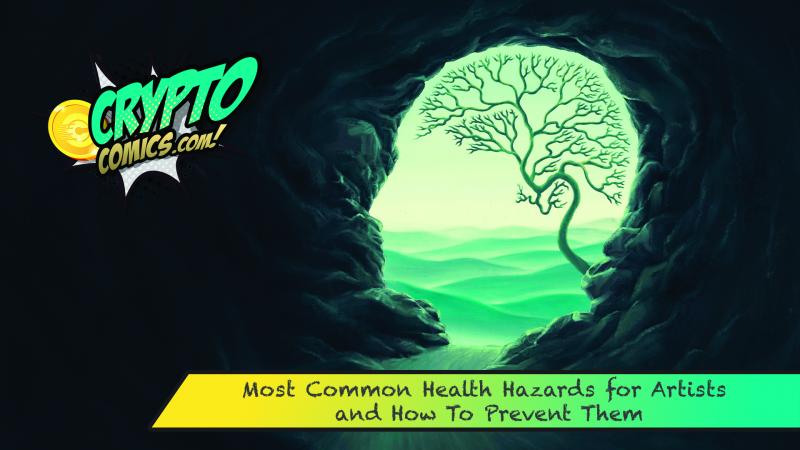by Matthew Russell - Posted 2 years ago

Welcome my CryptoComics Compatriots. Lately, I have been feeling my age. My other job is as a Graphic Designer for a printing company. With the holidays and New Year hitting us like a freight train, I spent a TON of hours hunched over my desk trying to get custom calendars and Holiday Cards out the door.
My neck was killing me, and I felt sluggish and at times, sore. I couldn’t turn my brain off at night, and barely made it through the holidays.
Artists, like any other profession, are susceptible to health hazards. These hazards can come in the form of physical, mental, or emotional stress and can have serious consequences if not addressed. Here are some of the most common health hazards that artists face and why:
Repetitive strain injuries: Artists, particularly those who work with fine art media such as pencils, pens, and brushes, are at risk of developing repetitive strain injuries. These injuries occur when the same muscles are used over and over again, leading to fatigue and pain. To prevent repetitive strain injuries, it is important for artists to take breaks, stretch, and use proper ergonomic techniques when working.
Eye strain: Artists who work with small, detailed media or who spend long hours staring at screens are at risk of eye strain. Eye strain can cause headaches, blurred vision, and dry eyes, and can be prevented by taking breaks, using proper lighting, and adjusting the screen to a comfortable distance and angle.

Stress and anxiety: The creative process can be stressful, and artists may face pressure to meet deadlines, produce high-quality work, and compete with others. This stress can lead to anxiety and other mental health issues. To prevent stress and anxiety, it is important for artists to set boundaries, take breaks, and seek support when needed.
Back and neck pain: Artists who work at a desk or easel for long periods of time may develop back and neck pain due to poor posture. To prevent back and neck pain, it is important for artists to use proper ergonomics and take
There are several things that artists can do to prevent repetitive strain injuries:
Take breaks: It is important to take breaks and stretch regularly to give your muscles a rest and prevent fatigue.
Use proper ergonomics: Make sure that your workspace is set up ergonomically, with your computer screen at eye level, your keyboard and mouse at a comfortable height, and your chair at a comfortable height.
Use the right tools: Use tools that are appropriate for the task at hand and that are comfortable to use. For example, if you are working with fine art media, use pens and pencils with comfortable grips.

Use proper techniques: Use proper techniques when working to reduce strain on your muscles. For example, hold your pen or pencil with a relaxed grip and use a light touch when drawing or writing.
If you are using a computer, be mindful of the hazards of Blue Light. It is known to cause eye strain and fatigue, and it can also disrupt sleep patterns.
One reason why blue light from a monitor can be harmful is that it has a shorter wavelength and higher energy than other types of light. This means that it is more likely to scatter and cause glare, which can strain the eyes and cause fatigue.
Another reason is that blue light can interfere with the production of the hormone melatonin, which is responsible for regulating sleep patterns. Exposure to blue light at night can suppress melatonin production, making it harder to fall asleep and leading to sleep disruption.
To reduce the negative effects of blue light, it is recommended to take breaks from screens, use blue light filters, and avoid screens before bedtime.
Exercise: Regular exercise can help strengthen your muscles and prevent strain injuries.
By following these tips, artists can help prevent repetitive strain injuries and maintain their health and well-being.
